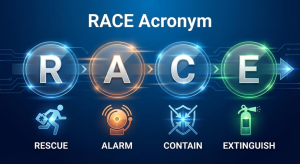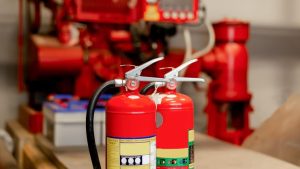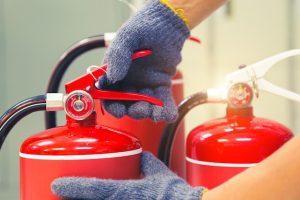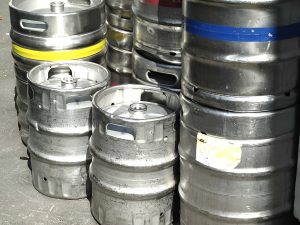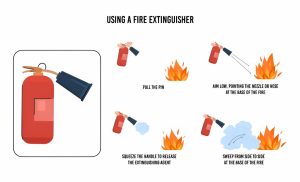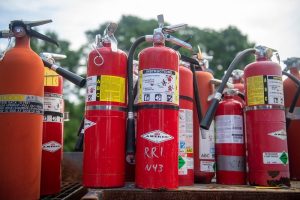Fire extinguishers are an essential component of fire safety, both at home and in the workplace. However, not all extinguishers are created equal, nor are they universally effective against every kind of fire. Choosing the right one is pivotal. In this guide, we’ll walk you through the process of selecting the perfect fire extinguisher for your needs.
Understanding Fire Classes
Before diving into extinguisher types, it’s essential to understand the different classes of fires:
-
- Class A: Fires involving solid combustibles like wood, paper, and cloth.
- Class B: Fires caused by flammable liquids such as gasoline, oil, and paint.
- Class C: Fires involving electrical equipment.
- Class D: Fires caused by combustible metals like magnesium, sodium, or potassium.
- Class K (or F in some regions): Fires involving cooking oils and fats.
Types of Fire Extinguishers and Their Uses
-
Water Extinguishers (Class A):
- Use: Effective for Class A fires.
- How they work: Cools the fire, removing the heat element.
- Caution: Never use on electrical or flammable liquid fires.
-
Carbon Dioxide (CO2) Extinguishers (Class B and C):
- Use: Suitable for electrical fires and flammable liquids.
- How they work: Displaces oxygen, suffocating the fire.
- Caution: Not effective for Class A fires and can cause frostbite if touched.
-
Dry Chemical Extinguishers (Multipurpose, Class A, B, and C):
- Use: Versatile, used for a combination of Class A, B, and C fires.
- How they work: Interrupts the chemical reaction of the fire.
- Caution: Leave a residue that needs to be cleaned.
-
Wet Chemical Extinguishers (Class K or F):
- Use: Designed especially for kitchen fires.
- How they work: Creates a cooling foam barrier and prevents re-ignition.
- Caution: Only effective for cooking oil or fat fires.
-
Metal/Sand Extinguishers (Class D):
- Use: For fires involving combustible metals.
- How they work: Forms a crust over the fire, isolating it from oxygen.
- Caution: Specific to the type of metal on fire.
Factors to Consider When Choosing an Extinguisher
1. Location:
- For kitchens, a Class K or F extinguisher is essential.
- Workplaces with electronics will need CO2 or multipurpose extinguishers.
- General home areas can benefit from multipurpose extinguishers.
2. Size and Weight:
- Larger extinguishers contain more extinguishing agent but are heavier.
- Consider who might have to use the extinguisher. Ensure it’s manageable in weight.
3. Rechargeability:
- Disposable extinguishers are used once and then replaced.
- Rechargeable extinguishers can be refilled by a professional after use.
4. Certification:
- Ensure the extinguisher is tested and certified by recognized standards organizations.
Placement and Training
After purchasing the right extinguisher:
- Placement: Install it in an easily accessible location, near potential fire sources but not too close.
- Training: Familiarize yourself and others with its use. Consider professional training sessions or local fire department workshops.
Maintenance
Regularly inspect your fire extinguisher to ensure it’s in working order:
- Check the pressure gauge monthly. It should be in the green zone.
- Examine the hose and nozzle for cracks or blockages.
- Ensure the safety pin is intact.
- For rechargeable models, have them serviced annually by a professional.
In Conclusion
A fire extinguisher is a crucial safety device, but its effectiveness depends on its appropriateness for the potential fire at hand. By understanding the different classes of fires, the types of extinguishers available, and the specific needs of your environment, you can make an informed decision. Always prioritize safety, and remember: while extinguishers are vital, they are part of a broader fire safety strategy that should include alarms, evacuation plans, and regular drills. Stay informed, stay prepared, and always prioritize safety.
Fire Safety FAQ: What You Need to Know
Is it possible to purchase my own fire extinguisher?
Yes, it is possible to buy your own fire extinguisher at home, business or vehicle. Only make sure that it fulfills the safety requirements, fits your risk of fire and that it is regularly checked to ensure its reliability.
What is the 75 rule for fire extinguishers?
The 75-foot provision mandates the use of portable fire extinguishers that are spaced in such a manner that no individual will cover a distance exceeding 75 feet to access them, and hence accessing them during emergencies and enhancing safety at the workplace.
Should we train children how to use fire extinguishers?
Children can learn basic fire-safety skills, but the use fire extinguisher responsibility should fall to trained adults or mature teens. Younger children should focus on recognizing danger, alerting others, and evacuating safely rather than attempting to operate an extinguisher during a fire.
What are the 3 checks and a rock rule for fire extinguishers?
The rule involves pressure checking, physical examination and accessibility and rocking or shaking of dry-chemical extinguishers to ensure that they do not settle on the powder rendering them reliable and available whenever needed.
Is it illegal to use a fire extinguisher when there is no fire?
Yes. Operating an extinguisher when there is no fire is regarded as misuse. It may pose risks, destroy property and attract penalties or legal repercussions depending on the safety rules and jurisdiction of the area.


